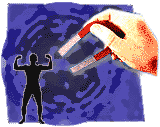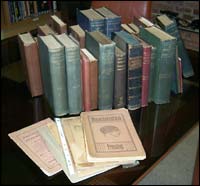 DISCOVERY! Maybe Elsie and Francis in Cottingley were telling the truth, after all! This artifact was just received (see photo) at the JREF museum, sent from the UK. It's a small apparent fossil of a fairy! Think what this means. Unlike those currently-popular and very expensive "feathered dinosaur" fake fossils now coming out of China, this item cannot be doubted. After all, Sir Arthur Conan Doyle himself validated the existence of fairies in the UK, so we know it must be so!
DISCOVERY! Maybe Elsie and Francis in Cottingley were telling the truth, after all! This artifact was just received (see photo) at the JREF museum, sent from the UK. It's a small apparent fossil of a fairy! Think what this means. Unlike those currently-popular and very expensive "feathered dinosaur" fake fossils now coming out of China, this item cannot be doubted. After all, Sir Arthur Conan Doyle himself validated the existence of fairies in the UK, so we know it must be so!
As of next Thursday, May 24th, we'll be up-and-running with our INTERNET radio show, broadcast live on the first Thursday of every week, beginning at 21:00 hours, Eastern Standard Time, which is 2:00 hrs. Greenwich Mean Time, on Friday. The first Friday of the week, of course! We intend to archive these programs in a limited fashion, so that folks anywhere can download them at an hour convenient to them. You'll require Windows Media Player, I'm told, and you just go to this web page, click on the radio button. This first one will be rough, just experimental, but you'll be able to communicate questions, comments, complaints, or subjects, to us via fax (+1 954 467 1660) or e-mail (randi@randi.org) or regular phone (+1 954 467 1112). Send in material in advance, if you like, and we'll handle it in turn. There will be volunteers on the phone and fax lines.
If you're now tuned in during the live show, you can still send in questions and comments, and we'll handle them the following Thrsday.
Later on, maybe we'll work in a bit of video, too....!
The JERUSALEM POST is an Israeli English-language daily from which I've previously quoted. Last week they commented on what was once known as "alternative medicine," but which is now designated as, "complementary medicine." This is a rather refreshing bit of news.
Complementary medicine treatments and technologies will not be added to the list of health services covered by the compulsory basic health insurance paid for by health insurance tax, until it is clear they are effective and safe, Health Ministry Director-General Boaz Lev said at a Haifa University conference last week. Lev said that it was impossible to ignore the fact that the "public are voting with their feet" and increasingly turning to complementary medicine practitioners for care; this puts pressure on the health system to recognize complementary techniques. The health funds and public hospitals all offer complementary medicine, but members and patients have to pay for them, as they are not included in the list of services.
Prof. Yohanan Ben-Bassat of the JDC-Brookdale Institute in Jerusalem argued at the conference on "Complementary Medicine in the Third Millennium" that such technologies should not be added to the list just because there is demand for them. He explained that the public generally "prefer complementary techniques to conventional medicine because they are concerned with vital strengthening of the whole body and allow the patient to take responsibility for his own health." He added that the attitude of complementary medicine practitioners towards their clientele is often more personal and warm than between doctors and their patients. Nevertheless, complementary medicine techniques should not be covered by the health funds (which get Treasury subsidies) until they have been proven to work and to cause no harm, he said. "Only the conventional biomedical model has shown efficiency in treatment and prevention, and such achievements are not paralleled in complementary
medicine," said Ben-Bassat.
Complementary medicine used on cancer patients, said Prof. Avraham Koten, head of Rambam Hospital's oncology institute, has to be assessed according to whether it improves patient's quality of life, as it does not cure them or even reduce the severity of the disease. He added that many cancer patients who use complementary therapies will find they cause negative side effects and even harm, because time is wasted and patients don't get proven therapeutic conventional treatments when they can produce the most benefit. While he called for objective research on complementary treatments because of their popularity, he said that so far "the efficacy of most alternative techniques is unproven, and most don't work."
Unbalanced people who go to complementary practitioners may get into trouble, warned Prof. Eli Somer, a Haifa University psychologist: "People who have emotional problems or have undergone trauma who voluntarily go to complementary practitioners don't know what to expect and after the treatment may find their condition has worsened." . . .
Untested Complementary Medicines Barred from Health List. By Judy Siegel
 As if to illustrate how such common-sense is needed, from an Internet site on "magnetic healing" we get the following:
As if to illustrate how such common-sense is needed, from an Internet site on "magnetic healing" we get the following:
Magnet therapy is based on the theory that each of the body's cells possesses tiny electromagnetic fields that fall out of alignment when disease is present. By applying magnets to the affected part of the body, the electromagnetic field is realigned. Proponents of magnet therapy claim that magnets open up capillaries and allow blood to flow freely, carrying oxygen to painful areas. Others say that magnets affect chemical processes between and within cells and stimulate acupuncture points and meridians.
The use of magnetism to sustain good health is recorded in the history of many ancient cultures. Reports from China show that magnetism has been used in coordination with acupuncture for over 2,000 years, and Hindu, Egyptian, and Tibetan writings all refer to a lodestone treatment for various body aches and pains and wound healing.
Yes, sounds just great. But there is not a shred of evidence to support this claptrap. It is pure bunkum. Consumers just don't know that, and continue to invest.
 We've just received a donation to the JREF library, a collection of 38 books on the subject of phrenology, along with a couple dozen pamphlets and booklets on the topic. Mostly in English, a few are German and Swedish. It is a most astonishing indication of the amount of time, money, thought, and hard work that has been squandered by the devotees of this strange pseudoscientific notion. We find here a small microcosm of quackery, an idea that took firm hold of a limited number of scientists and thinkers of the last century, and even today is looked upon by some as an effective means of trying to explain the differences between individuals.
We've just received a donation to the JREF library, a collection of 38 books on the subject of phrenology, along with a couple dozen pamphlets and booklets on the topic. Mostly in English, a few are German and Swedish. It is a most astonishing indication of the amount of time, money, thought, and hard work that has been squandered by the devotees of this strange pseudoscientific notion. We find here a small microcosm of quackery, an idea that took firm hold of a limited number of scientists and thinkers of the last century, and even today is looked upon by some as an effective means of trying to explain the differences between individuals.
The various natural bumps and depressions of the human cranium seemed, to pioneers around the turn of the 20th century like Franz-Joseph Gall, George Combe, and Johann Kaspar Spurzheim, to be evidence of various emotions, natural abilities, and characteristics. Much in the same way that the configurations of the planets and stars were looked upon as indicators of Man's destiny in the study of astrology, variations in skull shape could obviously, to the practitioners of phrenology, serve to reveal what went on inside that mysterious organ, the brain, and also what aspects of the thinking process were most — or least — developed in an individual.
Of course, phrenology also offered excuses for aberrant behavior. For example, a well-developed #5 bump could be held accountable for causing a fist-fight. "My Combativeness bump made me do it, your Honor!" (That's the bump behind and above the left ear, for the phrenologically-challenged.)
There is a spectrum of attributes in different degrees, that allows the interpreter to arrive at almost any desired conclusion. There are a choice of varying importance values for each of 33 (or 37) different areas, which are assigned to such qualities as, Benevolence, Veneration, Hope, Memory, and Passion, all of which we can relate to, but also a few such as Philoprogenitiveness, Adhesiveness, and Inhabitiveness — which might give us pause.
The books in this collection revel in philosophical voyages into each attribute, pointing out subtle modifying influences that one area might have on another. Indeed, as already mentioned, this process reminds us of the delight expressed by astrologers, who admonish the student not to neglect the effect that Saturn in opposition can have in modifying Mercury in Libra, changing the analysis that might otherwise indicate to the inexperienced practitioner that a fall from a bridge, or a really bad hangnail, is to be expected. The more variables there are, the more "sophisticated" the art becomes, and the more excuses are available for failure.
In the marvelous collection of quack devices that may be seen and wondered at in the Museum of Questionable Medical Devices in Minneapolis, Minnesota, there is an impressive machine known a "Psychograph." It reads bumps and depressions on the human skull, and proprietor "Dr." Bob McCoy is never happier than when he has a volunteer in the chair and can screw in the "sensors" to the surface of the victim's scalp to obtain a printed readout. His droll analysis of that skull's owner never fails to amuse, but it must also remind us that not too long ago, such interpretations were taken quite seriously, doubtless changed the lives of many, and made the phrenologists very, very, wealthy and respected.
Phrenology is pretty well into the dustbin of discarded scientific notions, but don't imagine for a moment that it cannot be resurrected, full-force. Bob McCoy tells us that quack devices like the Abrams Machine and the Drown device, both popular in the 1900's, are being brought back in the "PC" 2000's. And none of us are unaware that magnetic insoles — as exemplified in the still-flourishing Magneforce Florsheim shoes — are already back on the market, along with various magnetic belts, pads, bands, and patches sold by leading stores like Sears and Sharper Image. McCoy's museum boasts almost identical devices from the late 1800's.
On Wed, 9 May 2001, an inquirer wrote to Dr. Gary Schwartz informing him that someone had posted a message on the Internet claiming that he (Schwartz) had contacted one of the people that I had suggested be used as a panelist for the million dollar "grant" to the University of Arizona, and that this un-named person had said that he was "not contacted by Randi, and if they were, would not participate in the test."
First, note that there was no "test" involved. It was merely a proposed examination of the Schwartz data already produced, upon which the widespread media attention was based. Schwartz responded:
I did contact someone, and have email documentation that Randi lied about his conversation with this person.
Pause to reflect. Note that Schwartz — remember, he's the one who has been bleating about being "forthcoming," "up-front," and "sharing" in these matters — doesn't tell us which of these four persons he contacted. I just ask you to notice that. And as we will see, Dr. Schwartz's definition of "lied" may need some work.
Randi is a bright guy, but he is not to be trusted with the truth.
Really? Well, I checked with all four persons who were named by me as a suggested independent panel who could examine the Schwartz data. The person of whom Schwartz was writing, the un-named member of the suggested panel, was Dr. Stanley Krippner of San Francisco's Saybrook Institute. Stanley has worked with me previously on handling data of this sort. I most certainly did contact this man.
My conversation with Dr. Krippner revealed that he had decided that he was, in his own words, "overloaded" at present, and that he wished Schwartz would "get his act together." He agreed that he could be involved with a test of Sylvia Browne (no, a full 73 days after her agreeing to be tested, she has still not responded!) but he said that the Schwartz data was just so voluminous, he would not be able — at this time of the year — to take the time required to look over the material. In my original phone conversation with Stanley, I had spoken with him about both a test of Browne and an examination of the Schwartz data, but not a "test" of Schwartz. Krippner had agreed to be presently involved with Browne, but not presently with the Schwartz data, for the reasons given. He just cannot at this time take on new projects, but this is the sort of thing on which we have worked in the past, and Stanley is most knowledgeable and proficient in this field.
Dr. Krippner has suggested three other persons in parapsychology who I am currently reaching out to, with hopes that one of them would have the time — and interest — to examine the Schwartz data.
But there's more. I have received a most courteous letter from Dr. Imwalle at the University of Arizona, in response to my inquiry about whether the University would accept a grant of one million dollars from the JREF following a positive independent evaluation of Dr. Gary Schwartz's data. This was described here on the May 4th update, two weeks back. Dr. Imwalle informs us that he reviewed the offer with his colleagues on campus, and concluded that "the University is not prepared at this time to pursue the matter." He suggested that I "talk directly with Dr. Schwartz" about the "many issues [that] need to be discussed and resolved."
Gladly! As I have made clear to Dr. Schwartz, I am, and always have been, prepared to discuss the matter with him in depth as soon as he meets his obligation to submit videotapes, transcripts, and other data — as previously promised to the JREF — on other projects of his that have still not been examined. We had an agreement that this data would be sent to me, but it was never sent. I presume that this means we will shortly receive this material from the Human Energy Systems Laboratory.
Shall we start a Schwartz clock.....?
A reader comments:
I believe that if you reflect for but a moment, you will agree with me that in the predicting business, "failed prophecy" is merely a redundancy.
In this weeks Commentary you ask, "Or is 'failed prophecy' an oxymoron in the predicting business? Inquiring minds want to know."
The "words with no rhyme" inquiry has proven to be a far deeper and more involved subject that I had expected. Several persons sent me this example, believed to be from Steven Sondheim:
To find a rhyme for silver,
Or any "rhymeless" rhyme,
Requires only will, ver-
Bosity and time.
"Hey," writes Brian Buckeye, "if you go with "bread dough" for "widow," how about "door hinge" for "orange"?
No comment.
But Kyle Corbin really laid into me with:
E.g., when we discuss rhyming, "discuss" rhymes with "bus," but "discus" doesn't! It's obvious that purple doesn't rhyme with pull or with full; the final syllable of purple does rhyme with pull, but the final accented syllable of purple is pur-, so any word rhyming with purple must rhyme with the whole word. Likewise, subway and today don't rhyme, nor do lilac and back (as you said in your 54-word list).
You see, a "rhyme proper" is what people mean when they say "rhyme." I figured you knew, when you made your challenge, that when puzzlers and poets discuss rhyming, they mean the final syllable that has a main accent, plus anything afterwards. It's not just the final syllable of the word that must rhyme, but everything from the final syllable back to the final accented syllable. This is not arguing about definitions, as you described it. It is the only accepted method in poetry, etc., for determining whether words rhyme.
Reader Richard Wein chimed in with appropriate comments on what constitutes genuine rhymes....
lilac (back)
Words are normally only considered to rhyme if they match from the last stressed vowel up to the end of the word. For example, russet rhymes with gusset, but not with basset. The words above are stressed on the first syllable. (But perhaps the stress is less clear in US pronunciation than here in Britain.)
I would disagree with the following pairs that you gave as rhymes:
mollusk (corn husk)
subway (today)
violet (varlet)?
widow (bread dough)?
Okay. Let the following — mercifully — be the last of the poetry.....
I'm a poet.
Don't know it.
Feet show it.
They're long fellows.
Shortest poem: (?)
FLEAS
Adam
Had 'em.
 Moving right along, here's a favorite rug, solid color, measuring 9 meters by 12 meters. Big rug! The lady who owns it has discovered a section down the center — measuring one meter by 8 meters — that has become worn. She instructs her local rug-cutter to cut out that worn section and then cut the remaining material into just two pieces that can be exactly fitted together to form a proper rug. No angles (other than right) or curves. This is a perfectly legitimate problem, requiring no tricks, nothing like flipping part upside down, or cutting it into two long pieces of carpet yarn and re-weaving. Just cut into two pieces and reassemble.
Moving right along, here's a favorite rug, solid color, measuring 9 meters by 12 meters. Big rug! The lady who owns it has discovered a section down the center — measuring one meter by 8 meters — that has become worn. She instructs her local rug-cutter to cut out that worn section and then cut the remaining material into just two pieces that can be exactly fitted together to form a proper rug. No angles (other than right) or curves. This is a perfectly legitimate problem, requiring no tricks, nothing like flipping part upside down, or cutting it into two long pieces of carpet yarn and re-weaving. Just cut into two pieces and reassemble.
Solutions, as always, to randi@randi.org. Can't acknowledge all answers.
